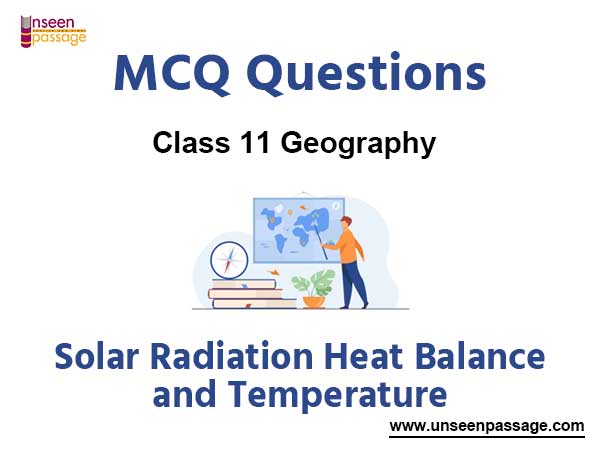Solar Radiation Heat Balance and Temperature MCQs Class 11 Geography
Please refer to Chapter 9 Solar Radiation, Heat Balance and Temperature MCQs Class 11 Geography with answers below. These multiple-choice questions have been prepared based on the latest NCERT book for Class 11 Geography. Students should refer to MCQ Questions for Class 11 Geography with Answers to score more marks in Grade 12 Geography exams. Students should read the chapter Solar Radiation Heat Balance and Temperature and then attempt the following objective questions.
MCQ Questions Class 11 Geography Chapter 9 Solar Radiation, Heat Balance and Temperature
Solar Radiation, Heat Balance and Temperature MCQ Class 11 Geography provided below covers all important topics given in this chapter. These MCQs will help you to properly prepare for exams.
Question. Earth receives almost all its energy from the
a. sun
b. moon
c. stars
d. none of these
Answer
A
Question. Which of the following has longest day and nights?
a. Poles
b. Equator
c. Tropic of Cancer
d. Tropic of Capricorn.
Answer
A
Question. Which factor determines the angle of inclination of solar rays?
a. altitude
b. ocean currents
c. latitude
d. rotation of’the earth
Answer
C
Question. The angle of inclination of sun’s rays at noon at Delhi (28°N):
a. 85°
b. 47°
c. 0°
d. 57°
Answer
A
Question. What is normal lapse rate?
a. 6.5°C per km.
b. 65°C per km.
c. 5.6°C per km.
d. 6.6°C per km.
Answer
A
Question. By which process the earth’s surface is heated?
a. convection
b. conduction
c. radiation
d. none of these
Answer
B
Question. The earth radiates energy to the atmosphere in:
a. Long wavelengths
b. Radiation
c. Insolation
d. Short wavelengths
Answer
A
Question. The earth transmits the heat by
a. conduction
b. convection
c. radiation
d. all of these
Answer
D
Question. The earth radiates energy to the atmosphere in:
a. Long wavelengths
b. Radiation
c. Insolation
d. Short wavelengths
Answer
A
Question. What is Isotherm?
a. The line joining the places of equal temperature
b. The incoming short wave radiation
c. The line joining the places of equal pressure
d. None of the above
Answer
A
Question. The sun is vertically over head at noon on 21st June at
a. the equator.
b. 23.5 degree N.
c. 23.5 degree S.
d. 66.5 degree N.
Answer
B
Question. Which processes operate on insolation during the passage through the atmosphere?
a. absorption
b. scattering
c. reflection
d. all of these
Answer
D
Question. Name the sphere which constitutes the earth.
a. atmosphere
b. hydrosphere
c. organic biosphere
d. lithosphere
Answer
A
Question. What is the temperature at the sun’s gaseous surface?
a. 570 degree Celsius
b. 5700 degree celcius
c. 57000 degree Celsius
d. 5000 degree celcius
Answer
B
Question. The heat transfer by contact is termed as
a. conduction
b. convection
c. radiation
d. none of these
Answer
A
Question. How long do the sun rays take to reach the earth?
a. 5 minutes
b. 6 minutes
c. 7 minutes
d. 8 minutes
Answer
D
Question. The combined reflection from the earth’s surface and clouds is known as
a. insolation
b. reflection
c. albedo
d. aurora Australis
Answer
C
Question. What least range of temperature is found between 20°S and 15°N?
a. 3°C
b. 5°C
c. 20°C
d. 10°C
Answer
A
Question. The heat energy absorbed by a known area in a fixed time is determined with the help of an instrument called
a. Psychrometer
b. Pyrheliometer
c. Thermometric well
d. Any instrument
Answer
A
Question. The sun is directly overhead at noon on 21st June at:
a. The equator
b. 23.5° S
c. 23.5° N
d. 66.5° N
Answer
A

